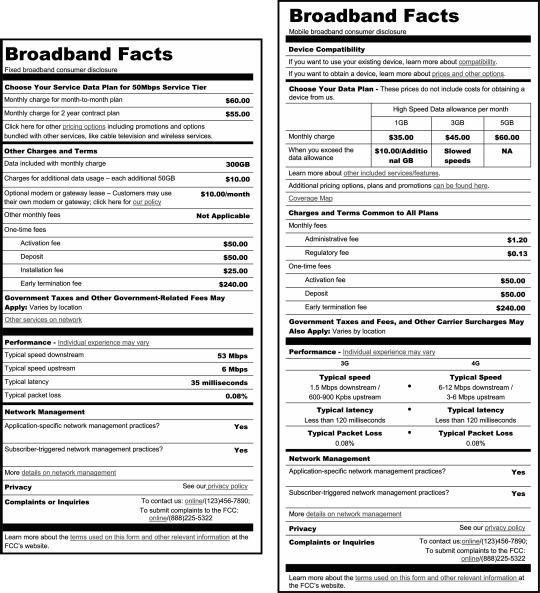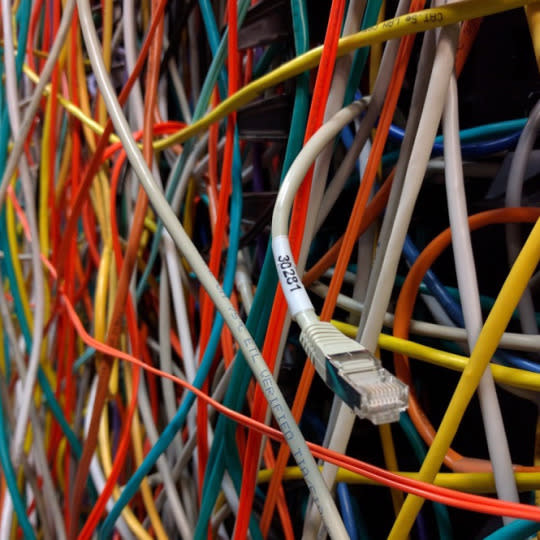FCC’s new “nutrition labels” for broadband services leave out a few ingredients

(Images via FCC)
If your Internet provider has been giving you indigestion, the Federal Communications Commission would like to help you figure out why.
Monday morning, the FCC announced a set of optional labels — modeled after those you find on food packaging — that wired and wireless broadband services can use to spell out what they offer and what it’ll cost.
These labels, developed with help from the Consumer Financial Protection Bureau, are supposed to ensure that customers can’t be surprised by hidden fees and service limitations after they sign their service contracts. The labels are a good idea — but they leave out some key data points.
Transparency about data caps and hardware fees
The FCC’s two label designs — one for mobile broadband and the other for fixed residential service — strive to put the most important numbers up front in bold type.
“What we’re unveiling today is a simplified approach to the presentation of the core information that consumers need to make an informed purchase decision,” said FCC chairman Tom Wheeler as he introduced the labels Monday morning.
Beyond the digits you’d expect an Internet provider to trumpet in its own ads — how fast, how much a month — the labels break out data caps (and what happens if you exceed them) as well as add-on fees for things like renting a cable modem, “administrative” costs, and exiting a contract early.
Data caps like Comcast’s 300 GB “threshold” and hardware fees like AT&T’s mandatory $7 surcharge for its U-verse fiber service regularly draw complaints from consumers who didn’t know about them. (Providers are understandably reluctant to complicate their sales pitches with such details.)
The FCC’s labels could neatly eliminate such confusion — if Internet providers adopt them. The FCC’s incentive: Using the labels to spell out the workings of their services will put ISPs in compliance with the the transparency provisions of the net-neutrality rules the Commission adopted last year.
The labels also include details about the performance of wired and wireless broadband. But download and upload speeds and the responsiveness and performance metrics of latency and “packet loss” can vary widely in practice, especially with mobile connections.

(Image by Rob Pegoraro/Yahoo Tech)
What else we’d like to see on the label
These labels are certainly well-intentioned, but they fail to cover many of the broadband breakdowns that lead to horror-story headlines. If the FCC wants to provide fair warning of the customer-service debacles that can lead embittered broadband users to Google “Kylo Ren lightsaber rage GIF” before venting on social media, other data points might be worth spotlighting:
Coverage accuracy: This would reflect how often the provider promises service at a given location, only to have customers who acted on that information find out it isn’t true — sometimes after moving to a new home that can now only be connected at an expense of thousands of dollars.
Service-window width: This would list the percentage of time a service call does not happen within the promised window (typically two to four hours). It’s not at all uncommon to wait for a technician longer than that. It is, however, mercifully rare that an impatient customer must seek the help of a reporter who in turn has to resort to calling the cable CEO’s mom.
Reboot factor: This number would reflect the average number of times that a tech-support rep asks the customer to reboot the modem, wireless router, or computer before finally admitting that, yeah, the problem might lie outside the customer’s residence.
Breakup time: This would gauge how long you must spend on the phone with a customer-service rep before the rep will consent to your request to cancel your service. We could also name this measurement the “Block Bit” (after tech journalist Ryan Block’s infamous 18-minute struggle to fire Comcast).
Things no label can cure
In all seriousness, nothing in these labels can stop an Internet provider from changing its mind about its policies. (See, for instance, AT&T’s recent move to enforce data caps, unless you also pay it for TV service, across its DSL and fiber residential broadband services.)
And, contrary to Wheeler’s statement that “the more consumers know, the better the opportunity for competition,” the labels can’t magically inject competition into markets that currently lack it. They can only fuel angst among the customers of a local telecom monopoly about the choices they might have elsewhere.
Further, many Internet providers seem to consider the whole idea a waste of time. The wireless trade group CTIA needed only a few hours to say that its member companies already provide sufficient notice to customers.
But maybe that points to the actual utility of these labels: If a provider takes the time to post one on its site, that’s a good sign… which will fill then fuel your angst as you realize that the company can’t connect your home anyway.
Email Rob at rob@robpegoraro.com; follow him on Twitter at @robpegoraro.

